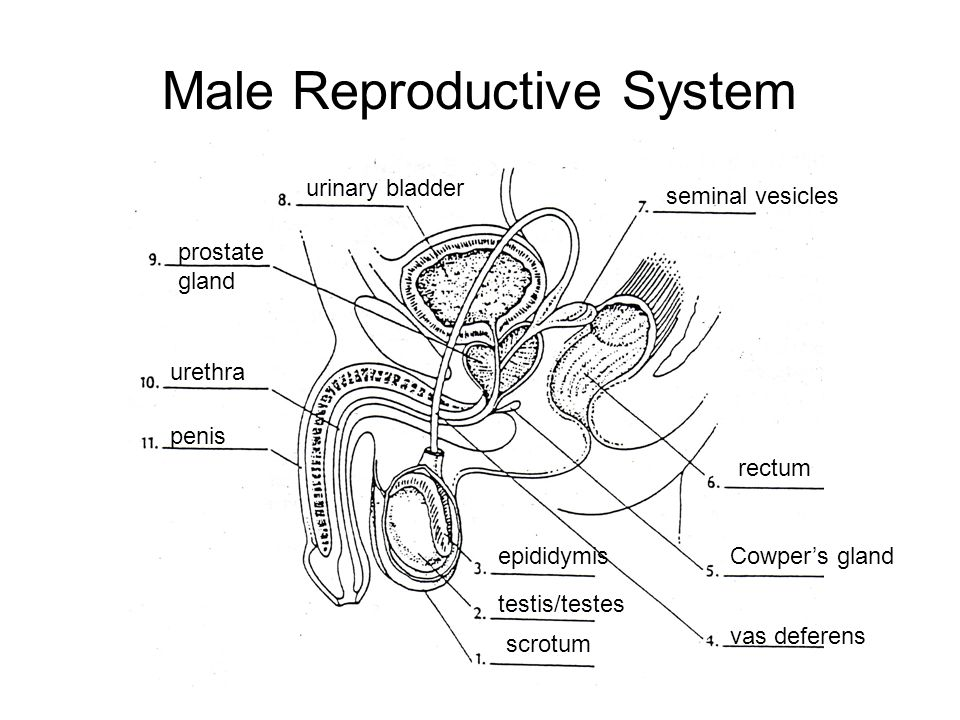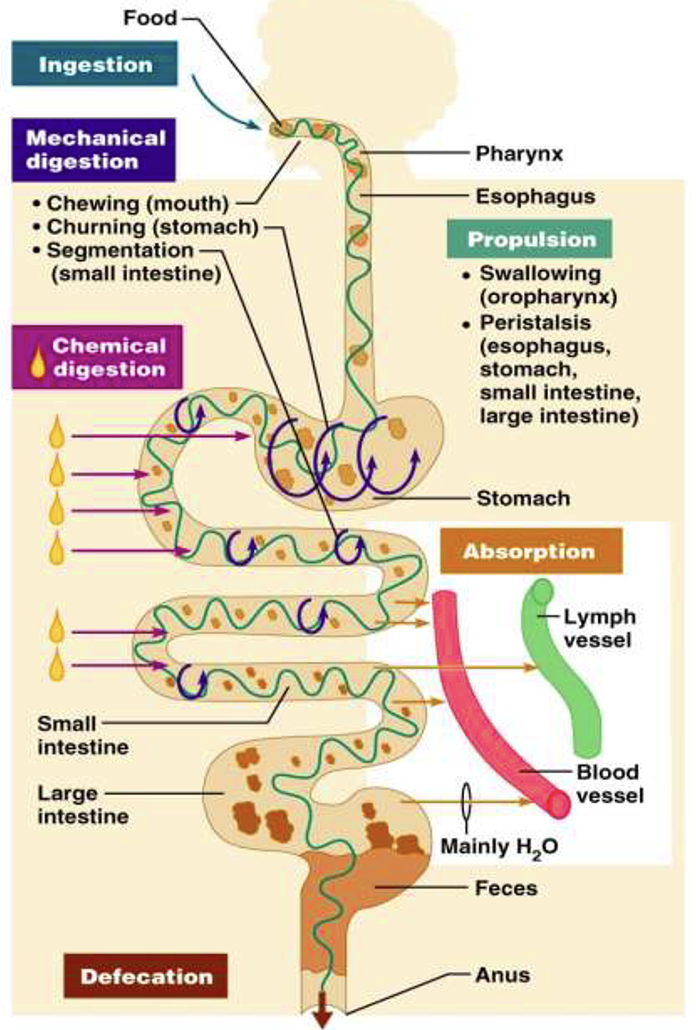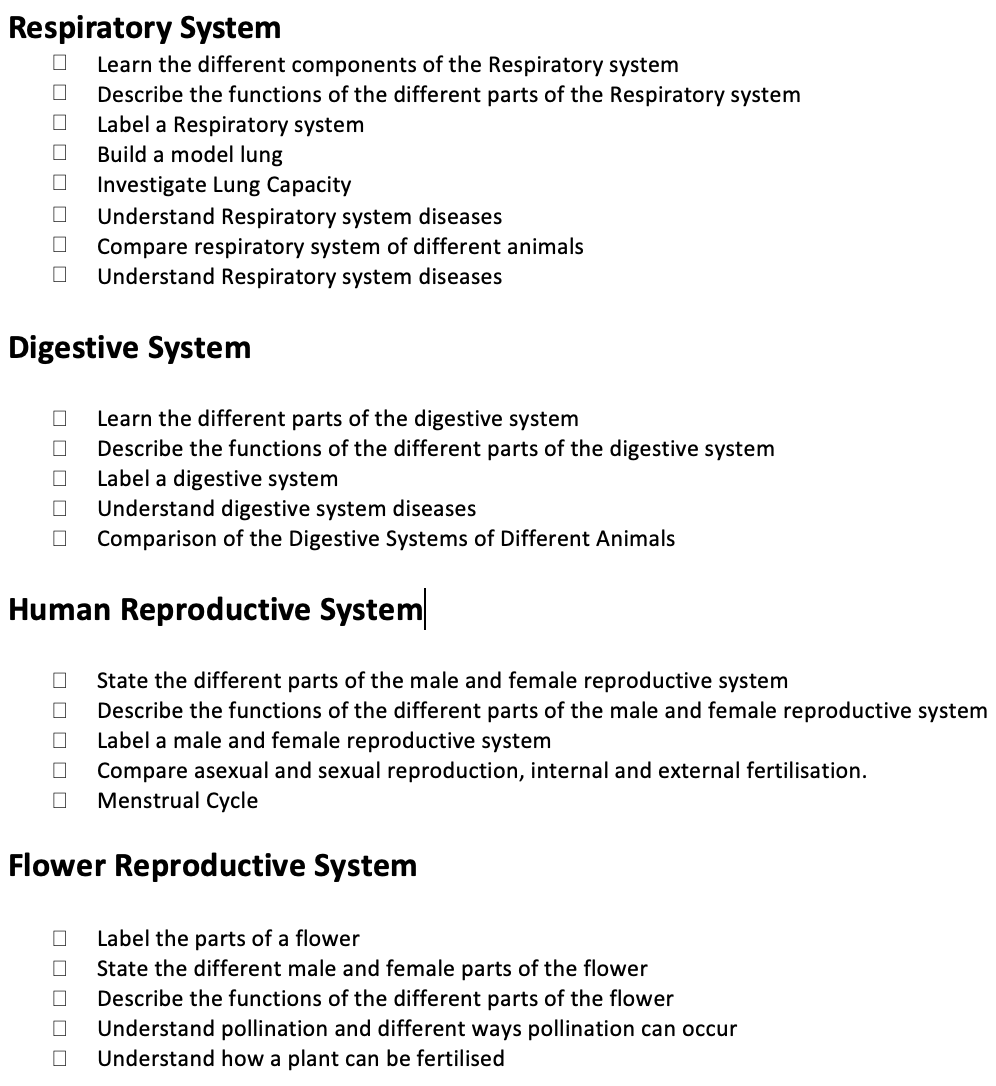
Science Revision Reproduction
Male Reproductive System
External Anatomy:
Scrotum: a pouch of skin holding the testes.
Testes: two oval-shaped glands producing sperm and testosterone.
Penis: The male sexual organ, containing the urethra.
Internal Anatomy:


Epididymis: A coiled tube attached to each testis, storing sperm.
Vas deferens: a muscular tube carrying sperm from the epididymis to the ejaculatory ducts.
Seminal vesicles: Two glands that produce fluid rich in fructose,
prostaglandins, and other substances that contribute to semen.
Prostate gland: a gland that surrounds the urethra, producing a fluid that helps neutralize vaginal acidity.
cowpers glands: two small glands that produce a clear mucus-like fluid to help sperm come through
Urethra: a tube that carries both urine and semen.
Female Reproductive System
External Anatomy:
Vulva: where urine leaves the body and where a baby comes out during birth
Internal Anatomy:

Ovaries: Two almond-shaped organs producing eggs (ova) and hormones (estrogen and progesterone).
Fallopian tubes: Two tubes connecting the ovaries to the uterus and fertilises egg
Uterus: A muscular organ where a fertilized egg implants and develops.
Cervix: The lower, narrow part of the uterus connecting to the vagina.
Vagina: A muscular tube leading from the cervix to the external genitalia.
Internal Fertilization:
Occurs: Inside the female body.
Examples: Humans, mammals, birds, reptiles.
Advantages: Protects the embryo, higher fertilization success.
Disadvantages: Fewer offspring, complex mating behaviors.
External Fertilization:
Occurs: Outside the body, often in water.
Examples: Fish, amphibians, some aquatic invertebrates.
Advantages: Produces many offspring, no need for mating contact.
Disadvantages: Vulnerable eggs, lower fertilization success
Menstrual Cycle:
Overview of the Menstrual Cycle:

A sequence of events that prepares the female body for pregnancy.
The cycle typically ranges from 25 to 36 days, with only 10-15% of women having a 28-day cycle.
It consists of four main phases.
Phases of the Menstrual Cycle:
Menstruation:
The uterine lining breaks down and is shed along with blood through the vagina.
Menstrual bleeding typically lasts 5-7 days.
Follicular Phase:
Occurs between the end of menstruation and ovulation.
Estrogen levels rise, and the uterine lining thickens in preparation for pregnancy.
One egg in the ovary begins to mature.
This phase lasts about 6-7 days.
Ovulation:
An egg is released from the ovary into the fallopian tube.
The uterine lining continues to thicken to prepare for potential fertilization.
Ovulation usually happens between the 12th and 14th day of the cycle.
Luteal Phase:
The ovary releases hormones to maintain the endometrium for potential implantation.
If fertilization does not occur, the uterine lining breaks down, leading to menstruation.
This phase typically lasts 12-14 days.
Fertilization:
The ovum lives for about 24 hours after ovulation.
Sperm can survive for around 2 days in the female reproductive tract.
If fertilization occurs, the ovum travels down the Fallopian tube and implants in the uterus about 5-7 days after fertilization.
SEXUAL REPRODUCTION IN PLANTS


MALE
A thin stalk, called the filament, is attached to the flower.
A small sack called the anther is attached to the top of the filament. The anther contains a fine yellow powder called pollen, which produces sperm cells.
FEMALE
The small tip that sticks out of the flower to collect pollen is called the stigma.
The stigma is attached to a long tube that transports pollen. This is called style.
The style moves pollen from the stigma to a round section at the base of the flower. This is the ovary. Just like in humans, the ovary contains eggs. These are the female sex cells. When male sex cells in the pollen reach the eggs, they combine to form seeds.
Asexual Reproduction in Plants
What is Asexual Reproduction?
Reproduction without a partner.
It involves mitosis: one cell splits into two identical cells.
Used for growth and creating new plants.
Types of Asexual Reproduction
Vegetative Propagation:
Plant make special structures from roots, stems, or leaves.
Examples:
Tubers: Potatoes grow into new plants.
Bulbs: Onions, tulips, daffodils, and lilies grow into new plants.
Runners: strawberries—stems that grow along the ground, producing new plants at intervals.
Cuttings:
piece of stem dipped in rooting hormone and planted.
Grows roots through mitosis, becoming a new plant.
Common for trees and shrubs like roses.
Spores:
Tiny, single-celled structures with a hard outer coating.
spread by wind, water, or animals.
germinate in suitable conditions to form new plants.
Found in ferns and mosses.
Comparison of Spores and Seeds
Spores: Asexual reproduction, single-celled, produced in large numbers.
Seeds: Sexual reproduction, multi-celled, result of pollination.
Advantages and Disadvantages of Asexual Reproduction
Advantages:
Faster and easier than sexual reproduction.
Requires less energy.
Disadvantages:
Offspring are identical to their parents.
Increased risk if environment changes or disease occurs.
Comparison of Asexual and Sexual Reproduction
Asexual: Faster, less energy, but riskier due to identical offspring.
Sexual: Slower, more energy, but offspring have varied traits, increasing survival chances.
‘
Digestive System
https://www.purposegames.com/game/digestive-syste,m-labeling-interactive-game

Functions of the Digestive System

Ingestion
Food enters through the mouth, is chewed, and swallowed as a mush
Digestion
Mechanical: Food is physically broken down in the mouth and stomach.
Chemical: Enzymes digest food into nutrients in the stomach and small intestine.
Secretion
Digestive organs release enzymes and fluids for digestion.
Absorption
After food is broken down in your digestive system, the nutrients get absorbed into your blood or lymph. From there, they travel to different parts of your body where your cells use them.
Elimination
Waste is expelled from the body through the rectum and anus.
Organs of the Digestive System
Gastrointestinal Tract (GI)
Continuous tube from mouth to anus
Includes mouth, oral cavity, esophagus, stomach, small intestine, large intestine, rectum, and anus
Accessory Structures
Teeth, tongue, salivary glands, liver, gallbladder, and pancreas

Mouth and Oral Cavity
Processes in the Mouth
Ingestion
Mechanical digestion (mastication)
Chemical digestion (amylase in saliva)
Role of the Tongue
Manipulates food during mastication
Contains taste buds for taste sensations
Teeth
Types of Teeth
Incisors, canines, premolars, and molars
Functions
Adapted for mechanical digestion (mastication)
Movement of GI Tract
Types of Movements
Peristalsis
wave like movement that occours from the pharynx to the rectum
Mixing
Mixing motion in the oral cavity and stomach
Segmentation activates circular muscles in your intestines that contract to move food back and forth, a bit like the churning of a washing machine. This churning gives food in the intestines a chance to mix with gastric juices and helps break it down into smaller pieces for digestion
Stomach
Functions of the Stomach
Food storage
Mechanical and chemical digestion
Structures
Cardiac sphincter
Pyloric sphincter
Folds for surface area
Small Intestine
Characteristics
long tube with small diameter
Adds fluids and enzymes for digestion
Absorption
Conversion of large molecules to smaller ones for absorption
Large Intestine
Functions
Water reabsorption
Storage of waste material before defecation
OVERALL MOVEMENT
 Pepsin: Breaks down proteins into smaller peptides in the stomach.
Pepsin: Breaks down proteins into smaller peptides in the stomach.
Lipase: Breaks down fats into fatty acids
Amylase: Breaks down carbs into simple sugars
Villi are tiny, finger-like projections found in the small intestine. They play a crucial role in the digestive system by helping to absorb nutrients from the food we eat.
Respiratory system
Function of the Respiratory System:
Supplies blood with oxygen for delivery to the body.
Removes carbon dioxide and water, waste products of respiration.
Components of the Respiratory System:

Nose and Mouth: Entry points; warm air.
Pharynx (Throat): Transports air, food, water; includes trachea and esophagus.
Larynx (Voice Box): Contains vocal cords.
Trachea (Windpipe): Carries air from larynx to lungs; protected by cartilage.
Bronchi/Bronchial Tubes: Two tubes from trachea to each lung; split into bronchioles.
Alveoli (Air Sacs): Tiny sacs in lungs for gas exchange.
Diaphram: muscle that helps you breathe by contracting to allow your lungs to expand and take in air.
Breathing and Respiration:
Respiration: Obtaining and using oxygen, removing carbon dioxide & water.
Breathing:
Inhale: Diaphragm contracts, lungs expand.
Exhale: Diaphragm relaxes, air exits.
Cellular Respiration: Uses oxygen to release energy from food.
Gas Exchange:
Process: Oxygen is picked up by blood in alveoli; carbon dioxide is transferred to the lungs for exhalation.
Diffusion: Passive movement of molecules from high to low concentration; essential in gas exchange.
Common Pulmonary Diseases:
Examples: Pneumonia, Emphysema, Bronchitis, Asthma, Cystic fibrosis.
Aspects to study: Disease description, affected area, symptoms, causes (environmental/genetic), and treatment.
Objectives

Science Revision Reproduction
Male Reproductive System
External Anatomy:
Scrotum: a pouch of skin holding the testes.
Testes: two oval-shaped glands producing sperm and testosterone.
Penis: The male sexual organ, containing the urethra.
Internal Anatomy:


Epididymis: A coiled tube attached to each testis, storing sperm.
Vas deferens: a muscular tube carrying sperm from the epididymis to the ejaculatory ducts.
Seminal vesicles: Two glands that produce fluid rich in fructose,
prostaglandins, and other substances that contribute to semen.
Prostate gland: a gland that surrounds the urethra, producing a fluid that helps neutralize vaginal acidity.
cowpers glands: two small glands that produce a clear mucus-like fluid to help sperm come through
Urethra: a tube that carries both urine and semen.
Female Reproductive System
External Anatomy:
Vulva: where urine leaves the body and where a baby comes out during birth
Internal Anatomy:

Ovaries: Two almond-shaped organs producing eggs (ova) and hormones (estrogen and progesterone).
Fallopian tubes: Two tubes connecting the ovaries to the uterus and fertilises egg
Uterus: A muscular organ where a fertilized egg implants and develops.
Cervix: The lower, narrow part of the uterus connecting to the vagina.
Vagina: A muscular tube leading from the cervix to the external genitalia.
Internal Fertilization:
Occurs: Inside the female body.
Examples: Humans, mammals, birds, reptiles.
Advantages: Protects the embryo, higher fertilization success.
Disadvantages: Fewer offspring, complex mating behaviors.
External Fertilization:
Occurs: Outside the body, often in water.
Examples: Fish, amphibians, some aquatic invertebrates.
Advantages: Produces many offspring, no need for mating contact.
Disadvantages: Vulnerable eggs, lower fertilization success
Menstrual Cycle:
Overview of the Menstrual Cycle:

A sequence of events that prepares the female body for pregnancy.
The cycle typically ranges from 25 to 36 days, with only 10-15% of women having a 28-day cycle.
It consists of four main phases.
Phases of the Menstrual Cycle:
Menstruation:
The uterine lining breaks down and is shed along with blood through the vagina.
Menstrual bleeding typically lasts 5-7 days.
Follicular Phase:
Occurs between the end of menstruation and ovulation.
Estrogen levels rise, and the uterine lining thickens in preparation for pregnancy.
One egg in the ovary begins to mature.
This phase lasts about 6-7 days.
Ovulation:
An egg is released from the ovary into the fallopian tube.
The uterine lining continues to thicken to prepare for potential fertilization.
Ovulation usually happens between the 12th and 14th day of the cycle.
Luteal Phase:
The ovary releases hormones to maintain the endometrium for potential implantation.
If fertilization does not occur, the uterine lining breaks down, leading to menstruation.
This phase typically lasts 12-14 days.
Fertilization:
The ovum lives for about 24 hours after ovulation.
Sperm can survive for around 2 days in the female reproductive tract.
If fertilization occurs, the ovum travels down the Fallopian tube and implants in the uterus about 5-7 days after fertilization.
SEXUAL REPRODUCTION IN PLANTS


MALE
A thin stalk, called the filament, is attached to the flower.
A small sack called the anther is attached to the top of the filament. The anther contains a fine yellow powder called pollen, which produces sperm cells.
FEMALE
The small tip that sticks out of the flower to collect pollen is called the stigma.
The stigma is attached to a long tube that transports pollen. This is called style.
The style moves pollen from the stigma to a round section at the base of the flower. This is the ovary. Just like in humans, the ovary contains eggs. These are the female sex cells. When male sex cells in the pollen reach the eggs, they combine to form seeds.
Asexual Reproduction in Plants
What is Asexual Reproduction?
Reproduction without a partner.
It involves mitosis: one cell splits into two identical cells.
Used for growth and creating new plants.
Types of Asexual Reproduction
Vegetative Propagation:
Plant make special structures from roots, stems, or leaves.
Examples:
Tubers: Potatoes grow into new plants.
Bulbs: Onions, tulips, daffodils, and lilies grow into new plants.
Runners: strawberries—stems that grow along the ground, producing new plants at intervals.
Cuttings:
piece of stem dipped in rooting hormone and planted.
Grows roots through mitosis, becoming a new plant.
Common for trees and shrubs like roses.
Spores:
Tiny, single-celled structures with a hard outer coating.
spread by wind, water, or animals.
germinate in suitable conditions to form new plants.
Found in ferns and mosses.
Comparison of Spores and Seeds
Spores: Asexual reproduction, single-celled, produced in large numbers.
Seeds: Sexual reproduction, multi-celled, result of pollination.
Advantages and Disadvantages of Asexual Reproduction
Advantages:
Faster and easier than sexual reproduction.
Requires less energy.
Disadvantages:
Offspring are identical to their parents.
Increased risk if environment changes or disease occurs.
Comparison of Asexual and Sexual Reproduction
Asexual: Faster, less energy, but riskier due to identical offspring.
Sexual: Slower, more energy, but offspring have varied traits, increasing survival chances.
‘
Digestive System
https://www.purposegames.com/game/digestive-syste,m-labeling-interactive-game

Functions of the Digestive System

Ingestion
Food enters through the mouth, is chewed, and swallowed as a mush
Digestion
Mechanical: Food is physically broken down in the mouth and stomach.
Chemical: Enzymes digest food into nutrients in the stomach and small intestine.
Secretion
Digestive organs release enzymes and fluids for digestion.
Absorption
After food is broken down in your digestive system, the nutrients get absorbed into your blood or lymph. From there, they travel to different parts of your body where your cells use them.
Elimination
Waste is expelled from the body through the rectum and anus.
Organs of the Digestive System
Gastrointestinal Tract (GI)
Continuous tube from mouth to anus
Includes mouth, oral cavity, esophagus, stomach, small intestine, large intestine, rectum, and anus
Accessory Structures
Teeth, tongue, salivary glands, liver, gallbladder, and pancreas

Mouth and Oral Cavity
Processes in the Mouth
Ingestion
Mechanical digestion (mastication)
Chemical digestion (amylase in saliva)
Role of the Tongue
Manipulates food during mastication
Contains taste buds for taste sensations
Teeth
Types of Teeth
Incisors, canines, premolars, and molars
Functions
Adapted for mechanical digestion (mastication)
Movement of GI Tract
Types of Movements
Peristalsis
wave like movement that occours from the pharynx to the rectum
Mixing
Mixing motion in the oral cavity and stomach
Segmentation activates circular muscles in your intestines that contract to move food back and forth, a bit like the churning of a washing machine. This churning gives food in the intestines a chance to mix with gastric juices and helps break it down into smaller pieces for digestion
Stomach
Functions of the Stomach
Food storage
Mechanical and chemical digestion
Structures
Cardiac sphincter
Pyloric sphincter
Folds for surface area
Small Intestine
Characteristics
long tube with small diameter
Adds fluids and enzymes for digestion
Absorption
Conversion of large molecules to smaller ones for absorption
Large Intestine
Functions
Water reabsorption
Storage of waste material before defecation
OVERALL MOVEMENT
 Pepsin: Breaks down proteins into smaller peptides in the stomach.
Pepsin: Breaks down proteins into smaller peptides in the stomach.
Lipase: Breaks down fats into fatty acids
Amylase: Breaks down carbs into simple sugars
Villi are tiny, finger-like projections found in the small intestine. They play a crucial role in the digestive system by helping to absorb nutrients from the food we eat.
Respiratory system
Function of the Respiratory System:
Supplies blood with oxygen for delivery to the body.
Removes carbon dioxide and water, waste products of respiration.
Components of the Respiratory System:

Nose and Mouth: Entry points; warm air.
Pharynx (Throat): Transports air, food, water; includes trachea and esophagus.
Larynx (Voice Box): Contains vocal cords.
Trachea (Windpipe): Carries air from larynx to lungs; protected by cartilage.
Bronchi/Bronchial Tubes: Two tubes from trachea to each lung; split into bronchioles.
Alveoli (Air Sacs): Tiny sacs in lungs for gas exchange.
Diaphram: muscle that helps you breathe by contracting to allow your lungs to expand and take in air.
Breathing and Respiration:
Respiration: Obtaining and using oxygen, removing carbon dioxide & water.
Breathing:
Inhale: Diaphragm contracts, lungs expand.
Exhale: Diaphragm relaxes, air exits.
Cellular Respiration: Uses oxygen to release energy from food.
Gas Exchange:
Process: Oxygen is picked up by blood in alveoli; carbon dioxide is transferred to the lungs for exhalation.
Diffusion: Passive movement of molecules from high to low concentration; essential in gas exchange.
Common Pulmonary Diseases:
Examples: Pneumonia, Emphysema, Bronchitis, Asthma, Cystic fibrosis.
Aspects to study: Disease description, affected area, symptoms, causes (environmental/genetic), and treatment.
Objectives

 Knowt
Knowt